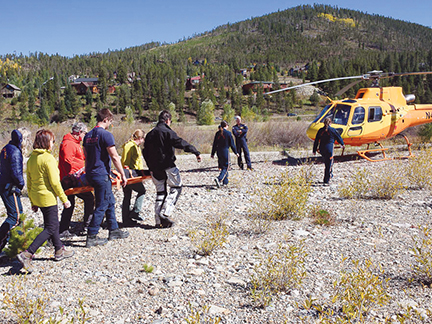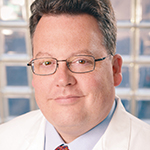From traumatic injuries in the Rockies to snakebites and overdoses in Appalachia, emergencies are as varied as the terrain
By JULIE MINDA
Throughout the year, emergency room clinicians at St. Anthony Summit Hospital in the heart of a Colorado Rockies recreation area stay busy tending to injuries of sportsmen and women whose adventures have turned into misadventures. Now that ski season is getting underway, the ER team is prepared for spikes in patients with traumatic head injuries and orthopedic injuries.

The hospital is in Summit County, where the highest peak tops 14,000 feet. It's no surprise then that year-round, the hospital also cares for patients with altitude-related conditions, particularly high-altitude pulmonary edema, the accumulation of excess fluid in the lungs which makes breathing difficult.

Dr. Marc Doucette, a St. Anthony ER physician, says the 35-bed St. Anthony in Frisco operates the only level 3 trauma center "in the heart of ski country." Summit County boasts four internationally known ski resorts within a half mile of each other. Doucette says, "the winter ski season is our busiest time of the year in the St. Anthony Summit Hospital ED, though summer is also becoming increasingly busy given the boom of summertime visitors to the mountains."
St. Anthony's emergency department logged 15,265 visits in 2021. St. Anthony's operates emergency and urgent care clinics at the bases of the Breckenridge, Keystone and Copper Mountain resorts. Emergency medicine physicians, nurses and support workers staff those locations.
Summer is the prime tourist season and tends to be the busiest time for agricultural and recreational injuries in the ER at St. Claire HealthCare. The 159-bed community hospital in Morehead, Kentucky, is in the foothills of the Appalachian Mountains. Nature lovers are drawn to the Red River Gorge in Daniel Boone National Forest and Cave Run Lake.

Dr. William Melahn says during peak tourist season, the emergency department treats an influx of people injured from falls, boating accidents, copperhead bites and ATV and motorcycle accidents. Melahn, who is vice president of quality and clinical affairs and a family medicine doctor with St. Claire of Morehead, is a member of the volunteer fire corps that responds to such emergencies.
Year-round, a significant and growing number of calls are in response to opioid overdose, says Melahn, who has lived in Morehead and practiced at St. Claire for 25 years. The 27 opioid deaths in Rowan County in 2021 were the second highest number reported by counties in a state with one of the country's worst opioid abuse profiles.
Heart of ski country
St. Anthony's parent system, Centura Health, operates the Flight For Life air and ground ambulance company. (Centura Health is a joint venture of CommonSpirit Health and Advent Health.) Flight For
Life transports critically ill or injured patients throughout Colorado as well as parts of Arizona, Kansas, New Mexico and Utah. The service has bases at five of Centura's hospitals as well as at Colorado airports for its fleet of five medevac helicopters,
three fixed-wing airplanes and four ground ambulances.

Kathleen Mayer, director of Flight For Life Colorado, says the crews, which are made up of nurses, paramedics and pilots or drivers, respond to a wide variety of calls, including for winter sport injuries, ATV accidents and car accidents. They transport patients from accident sites and from rural hospitals to high-acuity hospitals. Patients with life-threatening or limb-threatening injuries are taken to a Level 1 trauma center, those with less serious injuries go to a Level 2 trauma center.
The Flight For Life helicopter ambulance crews practice frequently with search and rescue teams, including with the teams' avalanche dogs. The dogs are trained to remain calm and task-oriented even with the sound of the helicopters' rotors near.
Mayer says avalanche transceivers in Flight For Life helicopters can detect avalanche beacons activated by skiers in distress. The Flight For Life team always has a snow safety technician on board on an initial flight into the area. That person can advise on the risk of additional slides. Mayer says the helicopter team has never triggered additional avalanche sliding due to the rotor's wash.
She notes that common injuries among avalanche victims can include bone fractures from having tumbled in the debris field with rocks and trees. Hypoxia — or an oxygen deficiency — can be caused by being trapped beneath the snow.
Search and rescue
Flight For Life's helicopters fly search and rescue teams into the backcountry and other remote locations landing as close as possible to where a rescue will take place.
Centura recently hosted a conference in Breckenridge for search and rescue teams. About 150 rescuers came to learn about practicalities of the work and to practice rescue techniques in the wilderness.
Mayer says Flight For Life is a break-even service; maintaining it and hosting educational conferences for search and rescue teams are mission-based undertakings for Centura.
Sole provider
The catchment area for St. Claire hospital in the Appalachian foothills has a different socioeconomic profile than the affluent ski basins of Colorado. Melahn says that the opioid epidemic is
part of a constellation of stressors that give the region a high rank on social vulnerability measures. Poverty, a lack of transportation and no health insurance cause people to delay getting health care before their conditions deteriorate.
But the leading health issue year-round is drug overdose. The incidence of overdose has been growing in recent years in Appalachia and is now at crisis levels, Melahn says. St. Claire has secured several grants to improve its primary care clinics' and behavioral medicine clinics' capabilities to treat patients with substance use disorder.
Melahn believes primary care physicians should be trained to do more to aid patients who have become dependent on opioids for pain control. He notes that the community needs addiction specialists, but "attracting an addiction specialist to a small area like this is very difficult. We have tried and they have not lasted."
Melahn says like other providers in rural areas, St. Claire is always attempting to recruit physicians specializing in pulmonary medicine, nephrology, oncology, urology, gastroenterology, obstetrics and gynecology, pediatrics and neurology, who want to work in rural areas. Some patients have to travel a minimum of 60 miles to see a specialist or a subspecialist. The use of telemedicine is limited, he adds.
"For many members of our population, travel is very expensive," Melahn says. If patients must be hospitalized at a higher acuity facility out of town, family members may be unable to visit for lack of reliable transportation. "In addition, I hear this over and over, they just do not want to go to the 'big city.'"
Melahn says it is usual for primary care physicians like him to become a "one stop shop," aiming to handle as much as they can locally. Referring patients elsewhere often is not an option, he says, because he knows many patients are unable to travel far to access care.
Melahn says he's built lasting, deep relationships with multiple generations of patients in Morehead.
"I have delivered a mother's daughter, then delivered her daughter's daughter, and now take care of all of them and the other members of the family," he says.
Housing and staffing challenges are interrelated concerns at St. Anthony
Even in an outdoor recreation mecca in a setting of awesome beauty it is difficult to recruit and retain staff, says Dr. Marc Doucette, an ER physician with St. Anthony Summit Hospital in Frisco, Colorado. The cost of living is steep and there is a severe shortage of affordable housing.
In a Feb. 16, 2021, story, the Summit Daily quoted the hospital's human resources director as saying that 25 people had turned down job offers in the prior three years because of housing costs and 50 people had resigned in the past year citing unaffordable housing costs as the reason.
St. Anthony plans to break ground in the spring on the first phase of an affordable housing project that will create 37 micro-condo units, primarily for its hospital employees. Some units may be allocated for occupancy by county employees or others. Centura Health will provide most of the funding, with potential investment by Summit County as well. Centura is St. Anthony's parent and is part of CommonSpirit Health.
Other staffing challenges for the hospital have to do with seasonal spikes in patient volume. Patient loads expand and contract significantly between the busy winter sports season, the less busy summer tourism season and the relatively slow "shoulder seasons." Those are the times between the end of ski season and beginning of summer tourism as well as between Labor Day and the start of ski season.
Doucette says St. Anthony Summit is adept at adjusting staffing for the seasonal fluctuations in patient loads. In most cases managers are able to appropriately staff the hospital and clinics with Centura clinicians.
Most physicians who augment the core staff at its mountain clinics during ski season come in from Centura's Denver-area facilities about 70 miles away. Centura has eight hospitals in the Denver metropolitan area. There have been times when St. Anthony in Frisco has contracted travel nurses and other clinicians to meet surge demand for services.
St. Anthony has six hospitalists and its specialty care services include cardiology; cardio-thoracic surgery; breast surgery; general surgery; vascular surgery; neurology; oncology/hematology, endocrinology; ear, nose and throat care. Doucette says that the level of demand for specialty care by the community's permanent population does not warrant the expense of hiring of a complete array of full-time specialists and subspecialists in that market. There is limited reliance on telehealth services. Some patients are referred or transferred for specialty care to Denver or Colorado Springs, a distance of about 140 miles.
"We've worked hard to grow the presence and regular availability of specialists in our community," he says. The hospital is continuing to recruit, or analyze the need for, a physical medicine and rehabilitation doctor, a gastroenterologist, and a neurologist, Doucette says, adding, "And, like the rest of the country we always have a need for greater mental health support here in Summit County."
— JULIE MINDA
The new High Altitude Research Center at St. Anthony Summit Hospital in Frisco, Colorado, is recruiting participants for its first study, which will look at how living at high altitude affects people's health, including whether lower concentrations of oxygen at higher elevations compounds complications for patients with diabetes, hypertension, hypoxia and pulmonary and/or heart diseases. Researchers will be on the lookout for how healthy bodies adapt to high altitude living too.
The center hopes to enlist about 3,000 study participants by December 2023.
People who are aged 18 and older and who have lived in Summit County, where Frisco is located, for at least three years and reside there at least six months of the year are eligible for the study. Participants fill out an online survey to enroll in the study. Once accepted, they will periodically be asked to complete questionnaires about their health.
According to information from the center, a goal of the Healthy Summit Research Project is to build a comprehensive picture of the longer-term effects of living at high altitude – in this case at or above 7,500 feet – coupled with lifestyle choices to promote or tax health. Initially, the center will use questionnaire responses to establish a baseline of the health of Summit County residents. Researchers will compare their data with health status and lifestyle information for the general population of the U.S. living at lower altitudes.
The research team plans to present its findings at the 2025 Hypoxia Symposium with one goal being to attract interest from the National Institutes of Health for funding or publication.
Partnership
The High Altitude Research Center is a collaboration between Centura Health, the University of Colorado's School of Medicine and the university's Altitude Research Center. Centura Health is part of CommonSpirit Health and is St. Anthony's parent.
The idea for the High Altitude Research Center arose about four years ago in talks between Centura Health and the university, says Dr. Michael Roshon. Clinicians and researchers from those organizations formed the committee that established the center and will determine the course of the center's research.
Roshon, vice president of physician residencies and research opportunities at Centura Health, is Centura's executive sponsor for the High Altitude Research Center. The university's representatives on the committee include Rob Roach, an associate professor and PhD researcher investigating human responses to hypoxia, and Dr. Ben Honigman, a clinical professor of emergency medicine and an associate dean of clinical outreach. Cardiologists and primary care physicians from Summit County also hold seats on the research advisory committee.
Understanding differences
According to data from the Summit County, Colorado, website, Summit County is a rapidly growing community. In 1970, there were 2,665 permanent residents, a fraction of the 31,055 in 2020. Roshon, a virologist who practices emergency medicine at a Centura Health hospital in Colorado Springs, noted that Summit County is known as a blue zone, or an area where people live healthier and longer than in other parts of the world.
Roshon says that while the effects of high altitudes on health have been studied extensively in very long-established communities, the effects have not been studied in relatively recently populated places. Summit County, Colorado, has become populated only in about the last 50 years.
Roshon notes that people have lived in the Himalayas for thousands of years, and he says "studies of genome adaptations have been conducted to reveal how ancestors adapted to the overwhelmingly diverse environments found in these high altitude areas." For instance, Sherpas use oxygen more efficiently at high altitudes than do climbers of other ethnicities.
Roshon says that no adaptation studies have been completed in the high-altitude areas of the U.S. For the High Altitude Research Center's study, he says, the hope is that the research team will be able to spot differences between Summit County residents and the general population of the U.S. The research team hopes the information will help them identify how to help people better adapt to living in high altitudes. Roshon also expects that the research team will focus on the effects of lower oxygen concentrations at high altitude on chronic diseases including heart disease, diabetes and lung disease.
